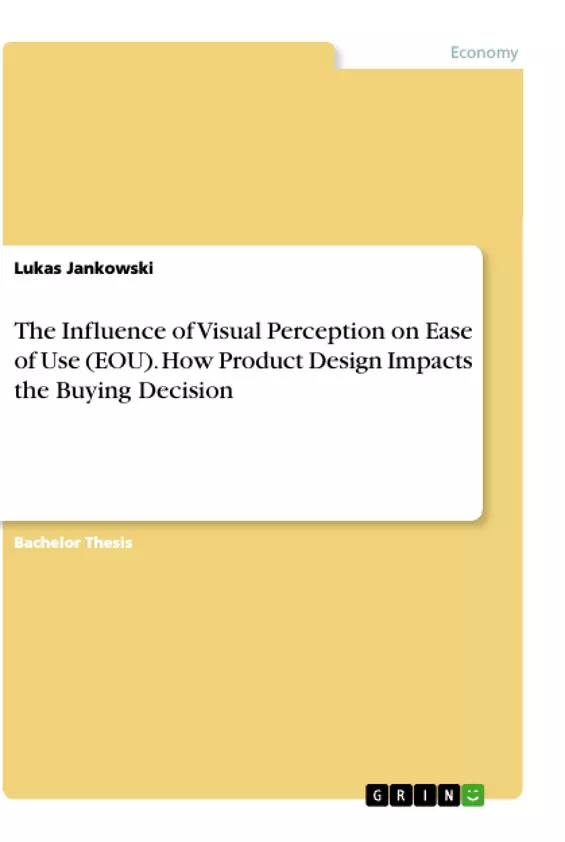The goal of this thesis is to give a structured overview of the current state of research with regards to the impact of visual appearance on Ease of Use (EOU) perceptions and their influence, in turn, on innovation adoption. Further, it will be examined which boundary conditions potentially inhibit this effect.
A product’s design is found to have multiple roles it can pursue to fulfill different consumer needs. Thus, an understanding of the relative influence of the various dimensions of product appearance on EOU perceptions is crucial to design an optimal product/system for the right context. Consumers, on the other hand, will benefit from these design cues as they provide valuable inferences about category membership, correct usage, expected performance and preference for an innovation.
Besides the importance of identifying potential determinants of ease of use (EOU) perceptions, it is critical for managers and designers to understand that these beliefs are often derived from the visual appearance of a product as an intuitive judgement heuristic. Visual appearance usually forms the first impression, hence judgements of visual newness are frequently made before the assessment of more functional attributes of the product. Not surprisingly, design has been rated "the most important determinant of new product performance" among marketing managers in 1988 (Bruce and Whitehead 1988).
Especially with regard to the fast technological development, the omission of usability concerns in favor of additional functionality has led to an increased complexity. This heightened complexity will potentially translate into "product return rate, future brand loyalty" and "delays in product usage" (Wood and Moreau 2006). Thus, reducing the usage uncertainty associated with an innovation is critical for both managers – in order to improve innovation acceptance.
Inhaltsverzeichnis (Table of Contents)
- Introduction
- Conceptual background
- Definition of keywords
- Theoretical Models
- The role of Ease of Use in the context of innovation adoption
- Determinants of Ease of Use
- The relative importance of EOU
- Visual perception as judgement heuristic for EOU
- How to design EOU
- Boundary Conditions of the influence of visual perception on EOU
- Conclusion
- Central Findings
- Managerial Implications
- Implications for future research
Zielsetzung und Themenschwerpunkte (Objectives and Key Themes)
The goal of this thesis is to provide a comprehensive overview of the current state of research regarding the impact of visual appearance on ease of use (EOU) perceptions and their influence on innovation adoption. Additionally, it will explore potential boundary conditions that could hinder this effect.
- Investigate the influence of visual perception on ease of use perceptions.
- Examine the relationship between ease of use perceptions and innovation adoption.
- Identify and analyze the boundary conditions that may influence the impact of visual perception on ease of use.
- Provide practical implications for managers and designers to optimize product design for enhanced ease of use.
- Suggest potential avenues for future research to further explore the complexities of visual perception and ease of use.
Zusammenfassung der Kapitel (Chapter Summaries)
- Introduction: This chapter introduces the thesis topic, highlighting the importance of ease of use in product design and innovation adoption. It emphasizes the challenges posed by increasing product complexity and the need to reduce uncertainty associated with new products for both managers and consumers.
- Conceptual background: This chapter defines key concepts such as ease of use and usability, distinguishing them from each other and emphasizing their connection to innovation adoption. It explores existing theoretical models and their relevance to understanding ease of use perceptions.
- The role of Ease of Use in the context of innovation adoption: This chapter examines the significance of ease of use in the process of innovation adoption. It explores various determinants of ease of use perceptions and discusses the relative importance of this factor in influencing adoption decisions.
- Visual perception as judgment heuristic for EOU: This chapter delves into the role of visual perception as an intuitive judgment heuristic for assessing ease of use. It explores how design elements can influence ease of use perceptions and analyzes the boundary conditions under which this effect might be mitigated.
Schlüsselwörter (Keywords)
The main keywords and focus topics of this thesis include: ease of use, usability, visual perception, innovation adoption, product design, judgment heuristics, boundary conditions, and managerial implications.
- Citation du texte
- Lukas Jankowski (Auteur), 2016, The Influence of Visual Perception on Ease of Use (EOU). How Product Design Impacts the Buying Decision, Munich, GRIN Verlag, https://www.grin.com/document/504558



